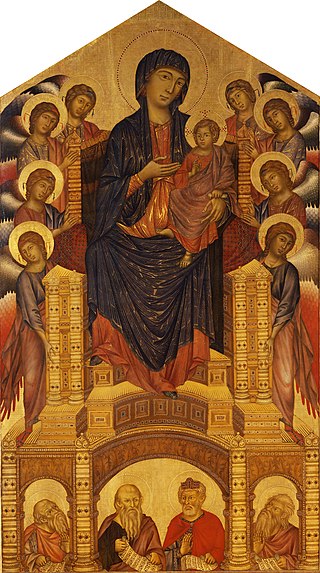Related Research Articles

Giovanni Cimabue, c. 1240 – 1302, was an Italian painter and designer of mosaics from Florence. He was also known as Cenni di Pepo or Cenni di Pepi.

Giovanni di Pietro di Bernardone, known as Francis of Assisi, was an Italian mystic, poet, and Catholic friar who founded the religious order of the Franciscans. Inspired to lead a Christian life of poverty, he became a beggar and itinerant preacher.

Assisi is a town and commune of Italy in the Province of Perugia in the Umbria region, on the western flank of Monte Subasio.

Pietro Cavallini was an Italian painter and mosaic designer working during the late Middle Ages.

Pietro Lorenzetti or Pietro Laurati was an Italian painter, active between c. 1306 and 1345. Together with his younger brother Ambrogio, he introduced naturalism into Sienese art. In their artistry and experiments with three-dimensional and spatial arrangements, the brothers foreshadowed the art of the Renaissance.
William Cornysh the Younger was an English composer, dramatist, actor, and poet.

The Basilica of Saint Francis of Assisi is the mother church of the Roman Catholic Order of Friars Minor Conventual in Assisi, a town in the Umbria region in central Italy, where Saint Francis was born and died. It is a papal minor basilica and one of the most important places of Christian pilgrimage in Italy. With its accompanying friary, Sacro Convento, the basilica is a distinctive landmark to those approaching Assisi. It has been a UNESCO World Heritage Site since 2000.

Assisi Cathedral, dedicated to San Rufino, is a major church in Assisi, Italy. This stately church in Umbrian Romanesque style was the third church built on the same site to contain the remains of bishop Rufinus of Assisi, martyred in the 3rd century. The construction was started in 1140 to the designs by Giovanni da Gubbio, as attested by the wall inscription visible inside the apse. He may be the same Giovanni who designed the rose-window on the façade of Santa Maria Maggiore in 1163.

The Little Flowers of St. Francis is a florilegium, divided into 53 short chapters, on the life of Saint Francis of Assisi that was composed at the end of the 14th century. The anonymous Italian text, almost certainly by a Tuscan author, is a version of the Latin Actus beati Francisci et sociorum eius, of which the earliest extant manuscript is one of 1390 AD. Luke Wadding ascribes the text to Ugolino da Santa Maria, whose name occurs three times in the Actus. Most scholars are now agreed that the author was Ugolino Brunforte.

The Master of Saint Francis was an anonymous Italian painter, perhaps of Pisan origin though probably trained in Umbria, working between 1250–1280. His work embodies an important aspect of the Italo-Byzantine style resulting from contact between Italian and Byzantine art of this period.

A choirbook is a large format manuscript used by choirs in churches or cathedrals during the Middle Ages and Renaissance. The book is large enough for the entire choir to read from one book. Choirbooks were generally put on a stand with the smaller boy sopranos in front and the men in back. As the printing of music became easier and paper replaced vellum, choirbooks fell out of favour, replaced by smaller, cheaper, and easier to handle partbooks and octavos.
The Caius Choirbook is an illuminated choirbook dating to the early sixteenth century and containing music by Tudor-period composers. The book appears to originate from Arundel in Sussex, and to have been created sometime in the late 1520s; the then Master of Arundel College, Edward Higgons, seems to have presented it to the collegiate chapel of Saint Stephen's in Westminster, where he was a canon beginning in 1518. The choirbook is now housed at Gonville and Caius College, Cambridge.
Richard Davy was a Renaissance composer, organist and choirmaster, one of the most represented in the Eton Choirbook.

The Isaac Master was an Italian Gothic painter active in the decoration of the Basilica of San Francesco d'Assisi in Assisi at the end of the thirteenth century. Master's name is derived from a fresco painting of the death of Isaac for which he is known, the fresco is located in the Upper Church of St Francis at Assisi, depicting Isaac blessing Jacob and Esau.

Chiara Offreduccio, known as Clare of Assisi, is an Italian saint who was one of the first followers of Francis of Assisi.
Robert Wylkynson was one of the composers of the Eton Choirbook. Wylkynson became parish clerk of Eton in 1496, then in 1500 he was promoted to Informator - the master of the choristers.

Saint Francis Receiving the Stigmata is a panel painting in tempera by the Italian artist Giotto, painted around 1295–1300 for the Church of Saint Francis in Pisa and it is now in the Musée du Louvre in Paris. It shows an episode from the life of Saint Francis of Assisi, and is 314 cm high by 162 cm wide. It is signed OPUS IOCTI FLORENTINI.
The Master of Staffolo was an anonymous late-Gothic style painter active in the region of Marche and Umbria.

Mauro Gambetti, OFM Conv. is an Italian Catholic prelate who has served as archpriest of Saint Peter's Basilica, Vicar General for the Vatican State, and president of the Fabric of Saint Peter since 2021. He was consecrated a titular archbishop on 22 November 2020 just before Pope Francis raised him to the rank of cardinal on 28 November 2020.
References
- Morello, Giovanni and Laurence B. Kanter, ed.: The Treasury of Saint Francis of Assisi. Milan; Electa, 1999.